Studies find good feed performance with soy protein concentrate
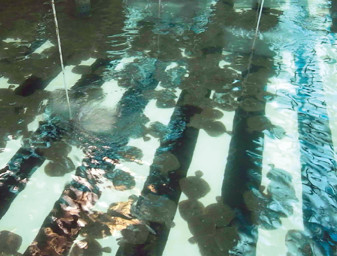
Turbot (Scophthalmus maximus) were introduced to China in 1992 and commercially produced since 1995. The high value of the fish — as high as $60/kg in the late 1990s — led to the rapid development of their aquaculture production. However, the quick growth lacked sustainability. In 2006, chemical residues were found in turbot in the Shanghai fish market. Prices for the fish dropped below $3/kg after the incident, and the industry almost crashed.
The turbot farmers who survived learned a serious lesson from the incident and started paying more attention to production practices. From that point, most turbot farmers have applied biosecurity and shifted from trash fish to manufactured feed for production.
In China, most turbot feeds contain about 50 percent crude protein and 10 percent fat. The industry commonly uses 45 to 60 percent fishmeal in the diets, since turbot are recognized as a highly carnivorous spices. Fishmeal prices increased dramatically in recent years and are expected to be higher in the future. Therefore, economical, high-quality turbot feed is needed for industry sustainability.
Feeding study, 2013
To evaluate the performance of turbot fed diets with high soy content, the authors initiated a feeding demonstration project in 2013 at Yantai Taihua Marine Technology Co., Ltd., located in Yantai, Shandong Province, China. Fish were raised in square, 6- x 6- x 0.5-m concrete tanks with 600 percent daily water exchange. The test diet was formulated to contain 50 percent protein and 10 percent fat, levels similar to those of the existing commercial turbot feeds.
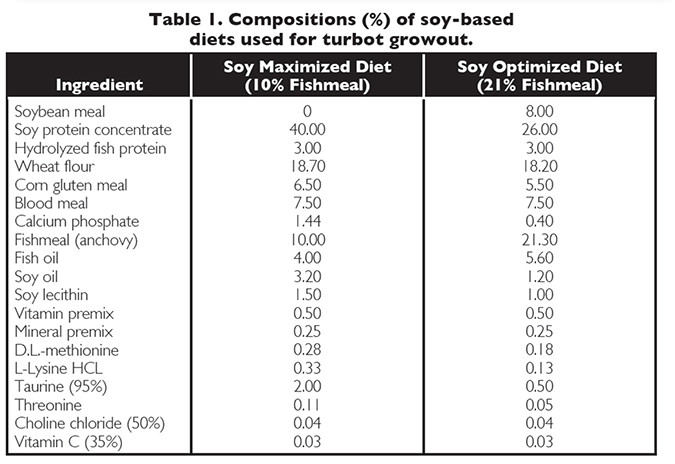
The formulation consideration was maximizing soy in the diet with proper nutrition for the turbot. The test diet, which contained 10 percent fishmeal and 40 percent soy protein concentrate (SPC) (Table 1), was fed twice daily. Approximately 1,000 fish were stocked in each of three tanks.
The fish grew from 167.5 to 302.5 g in 124 days, reflecting decent growth. The average feed-conversion ratio (FCR) and survival rate from two of the tanks were 1.02 and 99.8 percent, respectively. The FCR value was similar to that obtained using the commercial feed, according to the farm operator. The results indicated that proper formulation using soy protein concentrate could replace a significant quantity of the fishmeal in turbot diets.
Feeding study, 2014
In a 2014 study, the goal was to evaluate the growth and economic performance of turbot fed a soy-based diet with least-cost formulation. This study was also conducted at Yantai Taihua Marine Technology under the same conditions used in 2013.
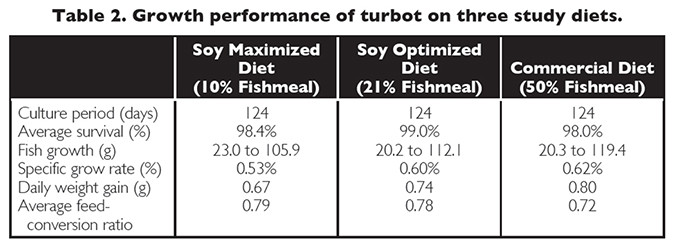
Fish with average initial weights of about 20 g were stocked at a density of 2,000 fish/tank. Formulated to be 50 percent crude protein and 10 percent fat (Table 1), the optimized test diet contained 21.3 percent fishmeal, 8 percent soybean meal and 26 percent soy protein concentrate. The 2014 study also used the 10 percent fishmeal diet from the 2013 study and a local commercial diet containing 50 percent fishmeal.
Data on fish growth, FCR and economic growth performance are presented in Table 2. The turbot grew from 20 to over 110 g. The average FCRs for the 10, 21 and 50 percent fishmeal diets were 0.79, 0.78 and 0.72, respectively. The feed costs per kilogram of fish weight gain are shown in Table 3.
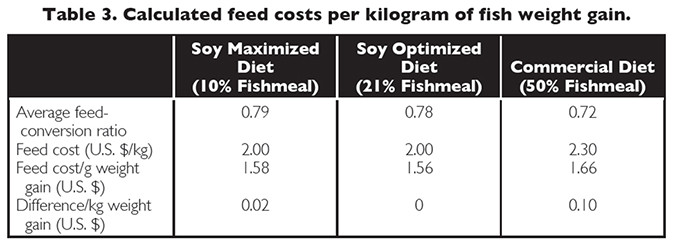
Although the commercial diet generated the lowest FCR, the feed cost per kilogram of weight gain was highest due to its high fishmeal content. The optimized soy diet that contained about 21 percent fishmeal generated the lowest feed cost per kilogram of weight gain.
Soy diet formulation
The aquafeed industry commonly recognizes that carnivorous species have a limited capability to digest plant protein. Soy contains a nitrogen-free extract (NFE), which is mostly non-starch polysaccharide that is poorly digested by carnivorous species. This limitation needs to be considered in feed formulation. Soybean meal contains 32 percent NFE, and 65 percent protein soy protein concentrate contains 16 percent NFE.
The ratio of animal protein to plant protein was 1:2 in the soy maximized diet and 1:1 in the soy optimized diet. Although the soy diets had different protein sources, the NFE values of the two diets were fairly similar, less than 7 percent. The study results showed no difference in fish growth performance between the diet treatments.
Perspectives
In general, carnivorous fish species have poor tolerance of soy NFE. Chinook salmon, for example, have zero tolerance. However, the tolerance among carnivorous species varies. Table 4 shows the soy NFE tolerance of various fish species.
Using a combination of dehulled soybean meal and soy protein concentrate can effectively replace fishmeal and lower the cost of feed while achieving adequate performance in fish growth and economy. A current study is evaluating the optimized soy diet when fed to 250-g submarket-size fish grown to a market size greater than 600 g.
Authors
-
Hsiang Pin Lan
U.S. Soybean Export Council
16305 Swingley Ridge Road, Suite 200
Chesterfield, MO 63017 USA
[103,114,111,46,99,101,115,115,117,46,116,99,64,110,97,108,104]
-
Zhang Jian, Tim O’Keefe, Michael Cremer, Ph.D.
U.S. Soybean Export Council
-
Zhang Xiuli, Sun Xueli, Niu Zhibin, Lv Jianguo
Yantai Taihua Marine Technology Co., Ltd.
Yantai, Shandong Province, China
Tagged With
Related Posts
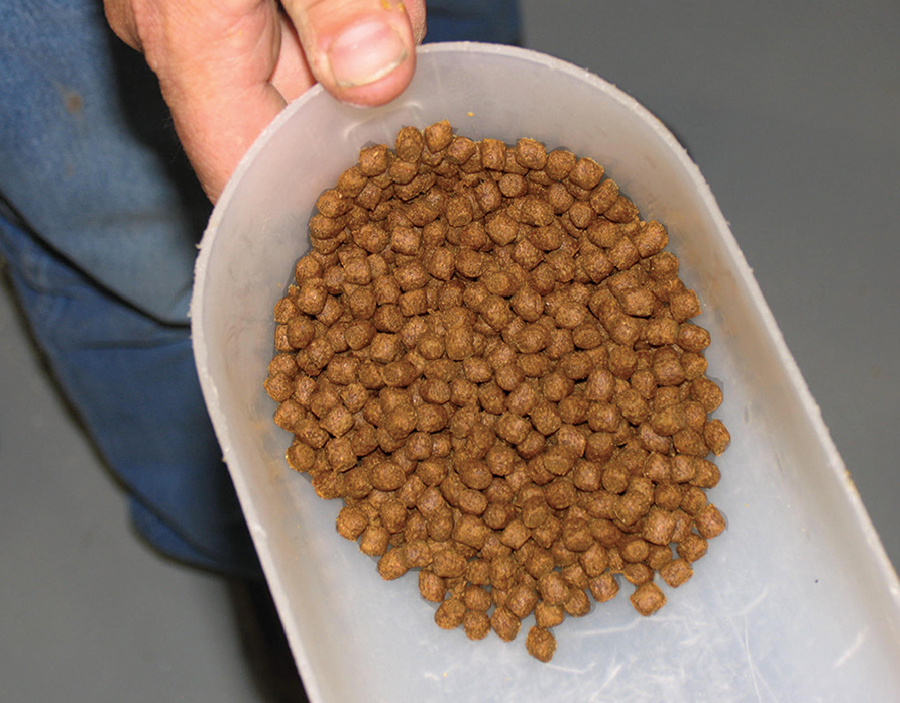
Aquafeeds
Insect meals: Novel protein, fat sources for farmed shrimp
Poor-quality ingredients can’t become good-quality ingredients. Quality protein is essential for the healthy growth of any omnivorous or carnivorous aquaculture species. Insect meals seem to fill this need, and their mass-scale production appears to be sustainable.

Innovation & Investment
USSEC, partners establish Asian aquaculture feed formulation database
To help produce high-quality aquaculture feeds, the U.S. Soybean Export Council spearheaded the Asian Aquaculture Feed Formulation Database project, designed as a reference tool for individuals involved in feed formulation, ingredient purchasing, quality control and research.
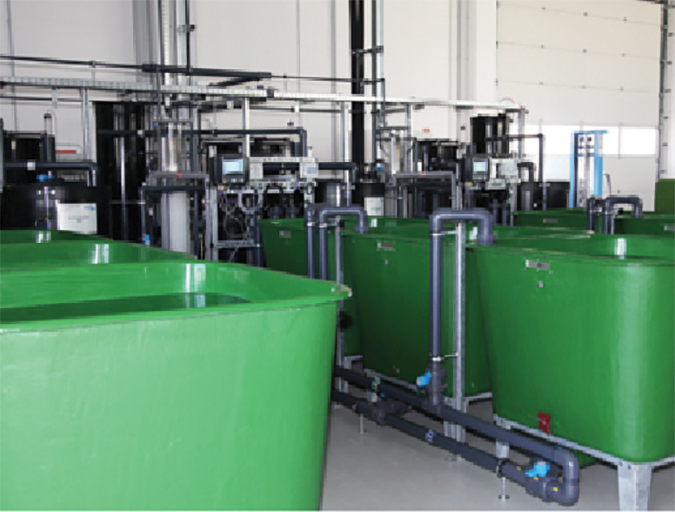
Health & Welfare
Biofilter inoculation in recirculating aquaculture systems
Biological filters are essential parts of recirculating aquaculture systems that transform toxic fish compounds such as ammonium and nitrite into less-harmful nitrate. The authors tested the convenience and efficiency of three methods for the initial inoculation of aerobic biofilters.
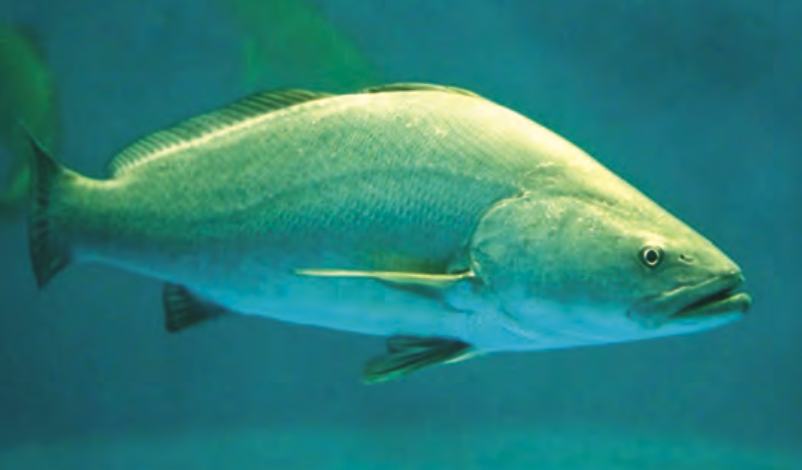
Responsibility
Aquaculture gives endangered totoaba a fighting chance
The tenuous fate of a pint-sized porpoise, the critically endangered vaquita, is linked to a fish targeted by poachers fueling China’s appetite for maws. The vaquita remains in peril, but aquaculture presents some hope for the totoaba.


